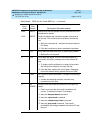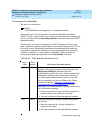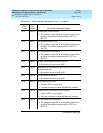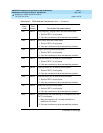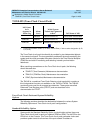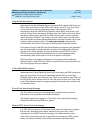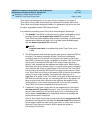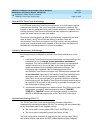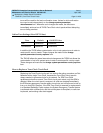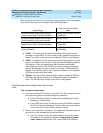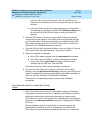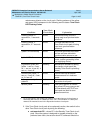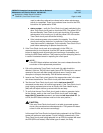
DEFINITY Enterprise Communications Server Release 5
Maintenance and Test for R5vs/si
555-230-123
Issue 1
April 1997
Maintenance Object Repair Procedures
Page 10-1481TONE-BD (Tone-Clock Circuit Pack)
10
High Reliability Option
Systems with the High Reliability Option (duplicated SPE, simplex PNC) have one
Tone-Clock circuit pack in each PPN control carrier, A and B. One Tone-Clock
circuit pack will be actively generating system clock signals for PPN
components, while the other will be in standby mode, ready to take over in the
event of a Tone-Clock interchange. Similarly, one Tone-Clock circuit pack will be
actively providing system tones for the PPN, while the other will be in standby
mode. Normally, the same Tone-Clock circuit pack will be active for both tones
and clock signals, but these responsibilities may be divided if neither circuit pack
is able to perform both functions. The status port-network command will
indicate which Tone-Clock circuit pack is actively performing each function.
For systems using the TN2182 Tone-Clock-Detector circuit pack, tone generation
and clock generation behaves the same as other clock boards with one being
active and one being standby. But the tone detector ports (ETR-PTs) of the
TN2182 are always considered available and in-service regardless of the
active/standby state of the tones or clock for a specific circuit pack.
EPN Tone-Clock circuit pack configuration is the same as for the Standard
Reliability Option. Each EPN Tone-Clock circuit pack will be active for both tones
and clock signals for its port network.
Critical Reliability Option
Systems with the Critical Reliability Option (SPE duplication and PNC duplication)
have two Tone-Clock circuit packs associated with the PPN, as in the High
Reliability Option case, and two more Tone-Clock circuit packs for each EPN. For
the EPN, these are in carriers A and B. As in the previous case, one Tone-Clock
in each Port Network is active, supplying system clocks and tones, and the other
is in standby mode.
Tone-Clock Interchange Strategy
The Tone-Clock circuit pack interchanges are controlled both by manual
intervention and by maintenance software strategies.
The manual interchange strategy for Tone-Clock circuit packs differs slightly
between the PPN and any EPNs on a system.
Manual PPN Tone-Clock Interchange
In a PPN with more than one Tone-Clock circuit pack, the intention is to assure
that the one considered most healthy is active at any given time.
This is
independent of the SPE Duplication strategy
, in the sense that the active
Tone-Clock circuit pack need not change with an interchange of SPE carriers.
Rather, except for the effect of the manual intervention discussed earlier,



